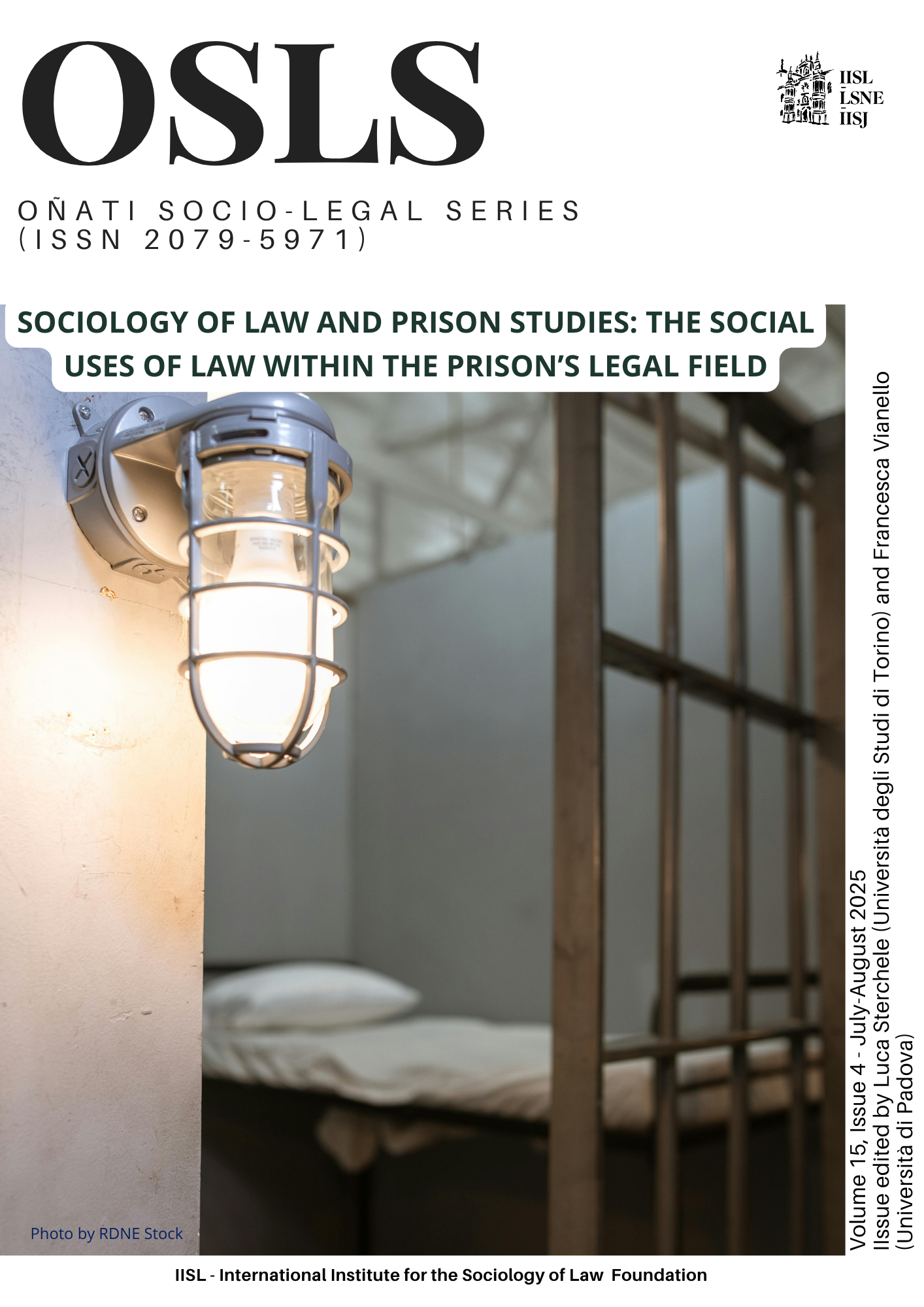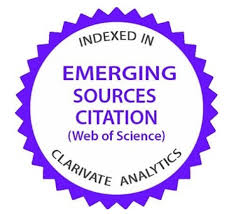Gangs, mafia, organised groups in prisons: the formal and informal strategies of managing the “public enemy"
Two cases-study between Global North and Global South
DOI:
https://doi.org/10.35295/osls.iisl.2076Keywords:
Organised crime, special prison regimes, mafia, gangs, desistanceAbstract
How does the label of “public enemy” influence the strategies of managing prisons? Using insights coming from on-the-field research conducted in different countries (mainly inside the prison for gangs in Triángulo Norte – El Salvador, Guatemala, Honduras – and into “high security” units for mafia members in Italy), the article focuses on the forced relationship between two complex organisations, the State and its punitive apparatus on one side and the organised groups, the non-state actor, on the other. Organised groups bring inside the walls of prison their habitus, organisation, leadership, hierarchy, symbols, typical of that continuum. The special units for dangerous prisoners are becoming a transnational strategy for experimenting different forms of relationship between State and criminal organisations: recognition, degradation, desertion and the underestimated desistance.
Downloads
Metrics
Global Statistics ℹ️
|
630
Views
|
866
Downloads
|
|
1496
Total
|
|
References
Aebi, M.F., and Cocco, E., 2024. SPACE I - 2023 – Council of Europe Annual Penal Statistics: Prison populations, Strasbourg: Council of Europe. http://www.antoniocasella.eu/nume/Aebi_space-i_2023_5june2024.pdf
Agamben, G., 2003. Stato di eccezione : Homo sacer, 2., 1. Turin: Bollati Boringhieri.
Becker, H.S., 1963. Outsiders: studies in the sociology of deviance. London: The Free Press of Glencoe.
Best, D., 2019. Pathways to recovery and desistance: the Role of the Social Contagion of Hope. Cambridge: Policy Press. DOI: https://doi.org/10.21428/cb6ab371.0716185b
Brotherton, D.C., 2007. Beyond Social Reproduction. Bringing Resistance Back into the Theory of Gangs. Theoretical Criminology [online], 12(1), 55–77. Available at: https://doi.org/10.1177/1362480607085794 DOI: https://doi.org/10.1177/1362480607085794
Brotherton, D.C., 2015. Youth Street Gangs. A Critical Appraisal [online]. London: Routledge. Available at: https://doi.org/10.4324/9780203727782 DOI: https://doi.org/10.4324/9780203727782
Bugnon, G., 2020. Governing delinquency through freedom: control, rehabilitation and desistance [online]. London: Routledge. Available at: https://doi.org/10.4324/9780429466175 DOI: https://doi.org/10.4324/9780429466175
Cannon, L., 1999. Official negligence: how Rodney King and the riots changed Los Angeles and the LAPD. Boulder: Westview Press.
Carter, J.H., 2014. Gothic Sovereignty: Gangs and Criminal Community in a Honduran Prison. The South Atlantic Quarterly [online], 113(3). Available at: https://doi.org/10.1215/00382876-2692155 DOI: https://doi.org/10.1215/00382876-2692155
Cohen, S., 1973. Folk, Devil and Moral Panics: The creation of the Mods and Rockers. Urban Life and Culture, 2(3), 380–381. DOI: https://doi.org/10.1177/089124167300200308
Conquergood, D., 1997. Street Literacy. In: J. Flood, S.B. Heat and D. Lapp, eds., Handbook of Research on Teaching Literacy Through the Communicative and Visual Arts. New York: Simon & Schuster and Macmillan, 354–375.
Cruz, J.M., et al., 2017. La nueva cara de las pandillas callejeras: el fenómeno de las pandillas en El Salvador [online]. Miami: Florida International University. Available at: https://lacc.fiu.edu/research/the-street-gangs-in-central-america-research-initiative-scrain/la-nueva-cara-de-las-pandillas-callejeras-el-fenmeno-de-las-pandillas-en-el-salvador-esp.pdf
De Giorgi, A., 2010. Il governo dell’eccedenza. Postfordismo e il controllo della moltitudine. Verona: Ombre Corte.
Dudley, S., 2004. Walking Ghosts: Murder and Guerrilla Politics in Colombia [online]. London: Routledge. Available at: https://doi.org/10.4324/9780203499566 DOI: https://doi.org/10.4324/9780203499566
Garland, D., 2001. Culture of Control: Crime and Social Order in Contemporary Society. Oxford University Press. DOI: https://doi.org/10.7208/chicago/9780226190174.001.0001
Goffman, E., 1961. Asylums. New York: Doubleday.
Irwin, J., 1970. The Felon. Saddle River: Prentice-Hall.
Jump, D., 2020. The Criminology of Boxing, Violence and Desistance [online]. Bristol University Press. Available at: https://doi.org/10.1332/policypress/9781529203240.001.0001 DOI: https://doi.org/10.1332/policypress/9781529203240.001.0001
Kee, R., 2000. The Green Flag: A History of Irish Nationalism. London: Penguin Books.
Leverentz, A.M., 2014. Ex-Prisoner’s Dilemma: How Women Negotiate Competing Narratives of Reentry and Desistance. New Brunswick: Rutgers University Press.
Lupo, S., 2004. Storia della mafia. Dalle origini ai giorni nostri. San Mateo: Donzelli.
Martinez-Herrera, E., 2002. National Extremism and Outcomes of State Policies in the Basque Country, 1979–2001. International Journal on Multicultural Studies, 4(1).
Matthews, R., 2009. Doing Time. An Introduction to the Sociology of Imprisonment. London: Palgrave Macmillan.
Pratt, J., 2007. Penal Populism [online]. New York: Routledge. Available at: https://doi.org/10.4324/9780203963678 DOI: https://doi.org/10.4324/9780203963678
Salazar Ugarte, P., 2012. Crítica de la Mano Dura. Cómo enfrentar la violencia y preservar nuestras libertades. Mexico City: Océano.
Simon, J., 2007. Governing Through Crime: How the War on Crime Transformed American Democracy and Created a Culture of Fear [online]. Oxford University Press. Available at: https://doi.org/10.1093/oso/9780195181081.001.0001 DOI: https://doi.org/10.1093/oso/9780195181081.001.0001
Sozzo, M., 2023. Reading penalty from the periphery. Theoretical Criminology [online], 27(4), 660-675. Available at: https://doi.org/10.1177/13624806231199749 DOI: https://doi.org/10.1177/13624806231199749
Sparks, R., and Simon, J., eds., 2012. The SAGE Handbook of Punishment and Society. London: Sage.
Sutton, J.R., 2013. The Transformation of Prison Regimes in Late Capitalist Societies. American Journal of Sociology [online], 119(3), 715-746. Available at: https://doi.org/10.1086/675300 DOI: https://doi.org/10.1086/675300
Sykes, G.M., and Matza, D., 1957. Techniques of neutralization: A theory of delinquency. American Sociological Review [online], 22, 664–670. Available at: https://doi.org/10.2307/2089195 DOI: https://doi.org/10.2307/2089195
Varese, F., 2010. Organized Crime. Critical Concepts in Criminology. London: Routledge.
Weaver, B., 2019. Understanding desistance: a critical review of theories of desistance. Psychology, Crime & Law [online], 25(6), 641–658. Available at: https://doi.org/10.1080/1068316X.2018.1560444 DOI: https://doi.org/10.1080/1068316X.2018.1560444
Published
How to Cite
Issue
Section
License
Copyright (c) 2025 Michele Miravalle

This work is licensed under a Creative Commons Attribution-NonCommercial-NoDerivatives 4.0 International License.
OSLS strictly respects intellectual property rights and it is our policy that the author retains copyright, and articles are made available under a Creative Commons licence. The Creative Commons Non-Commercial Attribution No-Derivatives licence is our default licence and it regulates how others can use your work. Further details available at https://creativecommons.org/licenses/by-nc-nd/4.0 If this is not acceptable to you, please contact us.
The non-exclusive permission you grant to us includes the rights to disseminate the bibliographic details of the article, including the abstract supplied by you, and to authorise others, including bibliographic databases, indexing and contents alerting services, to copy and communicate these details.
For information on how to share and store your own article at each stage of production from submission to final publication, please read our Self-Archiving and Sharing policy.
The Copyright Notice showing the author and co-authors, and the Creative Commons license will be displayed on the article, and you must agree to this as part of the submission process. Please ensure that all co-authors are properly attributed and that they understand and accept these terms.






















